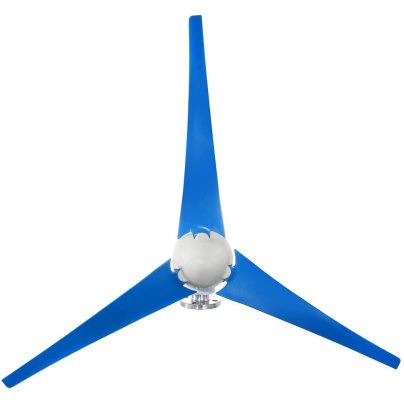
We may earn revenue from the products available on this page and participate in affiliate programs. Learn More ›
Home wind turbines provide a way to independently generate power. They typically contain three blades and use the wind to create electricity. Some wind turbines can be used with solar panels to generate even more power.
Home wind turbines can be installed and static, or they can be portable. While all are suitable for land, not all are made for marine applications. The best wind turbine for your situation depends on its intended use as well as which features matter most for your applications.
Keep reading to learn about details to consider when choosing a wind turbine, and check out some of the best residential wind turbines available on the market.
- BEST OVERALL: Pikasola Wind Turbine Generator
- BEST BANG FOR THE BUCK: Dyna-Living Wind Turbine Generator Kit
- BEST FOR OFF-GRID LIVING: Primus Wind Power Air 40 Wind Turbine Generator
- UPGRADE PICK: Nature Power 70701 Wind Turbine
- BEST WIND AND SOLAR KIT: ECO-WORTHY 800W Solar Wind Power Kit
- BEST FOR TRAVEL: Pacific Sky Power Travel Wind Turbine Generator

What to Consider When Choosing the Best Home Wind Turbine
There are many factors to consider when choosing the best residential wind turbine, including the number of blades, material, height, wind-speed rating, and energy output. The following are all the factors to consider before making a decision.
Local Zoning Laws and Height Restrictions
There are a few factors that affect where a wind turbine is placed. Some zoning laws require that the turbine be no more than 500 feet high. Wind turbines also need to be placed at a minimum height of 25 feet to catch the maximum amount of wind and provide the greatest number of benefits. Some turbines may be able to attach to a roof.
For both maximizing wind volume and abiding by local regulations, the placement really depends on where the property is located and whether the community has any restrictions. Check with the local zoning laws or the homeowners association to see what is allowed.
Wind in the Area
The amount of wind in the area is an essential consideration when purchasing a wind turbine. Some wind, of course, is desired. However, there is such a thing as too much wind. Before purchasing a turbine, always look for the “wind survival” speed and know how fast winds can be in the area. Some turbines can only handle winds up to 90 mph.
Areas that are at risk for hurricanes and tornadoes are generally not good areas for turbines, as winds from these storms can reach up to and over 100 miles per hour. Tornadoes can have wind speeds of up to 300 miles per hour, which is much higher than a wind turbine can accommodate. Very high winds like these can remove the turbine and endanger surrounding property.
Blades
Different wind turbines have varying numbers of blades. Three blades is standard, but turbines can have only one blade, four blades, or even more. Two blades are very energy efficient, so having more blades isn’t necessarily better.
Wind turbine blades can be made of different materials. In the past, wood was the chief material used to make wind turbines. Today, fiberglass-reinforced polyester, carbon fiber, and reinforced epoxy materials are more popular, as these materials allow the turbine to spin faster and capture winds at lower speeds. However, since these materials are challenging to recycle, newer materials such as bio-based composites like flax, hemp, and wood are being tested to solve the problem of recycling blades when they are at the end of their life.
Wind-Speed Rating
Every wind turbine has a wind-speed rating which is measured by an anemometer. This is the speed at which the turbine will produce the optimum amount of power.
Some wind turbines are designed to automatically shut off when wind speeds get too high. Wind speeds for turbines can be categorized by:
- Cut-in wind speed (also called starting wind speed): When the blades start rotating and generating power, generally between wind speeds of 6 to 9 miles per hour, this is cut-in wind speed.
- Rated wind speed: This is when the turbine is producing its maximum amount of power. Even if winds become higher, the turbine won’t be able to produce more power than this limit.
- Safe wind speed: The speed that turbines can safely operate, which is usually between 8 and 55 miles per hour.
- Maximum wind speed: Turbines have a maximum wind speed, which is the wind speed they can tolerate before they risk being damaged.
Energy Output
Different wind turbines have different energy outputs, which depend on the blade material and size, and the level of wind speeds the turbine can accommodate before having to shut off. Therefore, a larger turbine with larger blades will be able to capture more energy than a smaller one. The energy output is typically rated in watts.
Most turbines don’t operate near their maximum capacity for energy output, with typical outputs of 30 to 40 percent their capacity. However, even at this percentage, wind turbines can produce many megawatt hours of energy. A megawatt hour of energy is equivalent to 1,000 kilowatts of energy produced per hour.
Weight
If the plan is to mount the wind turbine on the roof, going with a lighter model may be best. However, if using a pole to support the turbine, the weight may not matter as much. Today’s wind turbines are typically made with composite materials that are lighter and therefore give users more flexibility with mounting the turbine.
Depending on the size and energy output of the turbine, it can weigh several hundred pounds when mounted on a pole. However, residential wind turbines typically only weigh up to 60 pounds, with some weighing only 25 pounds and portable options as few as 3 pounds. Smaller options are great for those looking for the best small wind turbine.
Material
Most wind turbines today are made with composite, lightweight materials. However, they can also be made out of plastic, metal, steel, or fiberglass. Iron and cast-iron components can be used as well, although they aren’t typically found on home wind turbines.
More eco-friendly materials, such as plant-based composites, are currently undergoing testing as wind turbine components. This includes the blades, which can help prevent these components from ending up in landfills, as many reinforced composites cannot be recycled.
Additional Features
Certain wind turbines come with kits that include everything the user needs to get started. Some turbines come with mounting equipment, such as poles, while others will not.
Turbines can also come with a controller that provides remote access to the device. Other turbines are waterproof-rated to ensure they can perform marine applications with anti-corrosion features. What additional features to choose depends on the user’s goals for their turbine.
Our Top Picks
After reviewing numerous options for the best home wind turbine, we evaluated them based on various typical home needs. Below are some of the best, organized by category. One of these may be the right pick for you to start producing extra energy by harnessing the power of the wind.
Best Overall
Pikasola Wind Turbine Generator
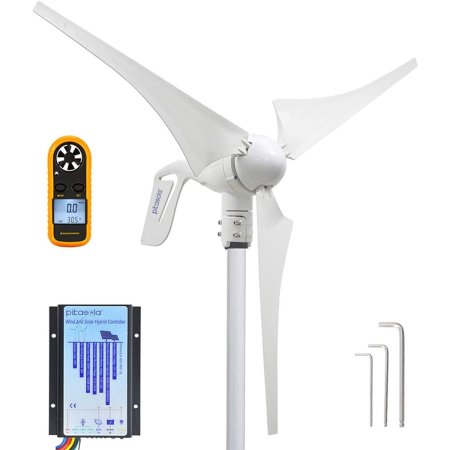
Pros
Cons
Product Specs
- Maximum power: 410 watts
- Rated wind speed: 13 miles per second
- Number of blades: 3
This mid-price-range wind turbine from Pikasola comes with nylon carbon fiber blades and a solar and wind charge controller, which helps users control the battery charge for a longer potential lifespan. It also has an integrated voltage regulator, so the turbine will automatically shut down when the battery is fully charged.
The product is also waterproof IP67, meaning it can withstand being dropped in water for up to a half hour. It also has open-circuit protection and an option to connect the wind turbine with a solar panel. The best place for installation is where the wind is strongest and there are no other tall obstacles nearby. It also comes with a gauge so it can measure wind speed to determine the best location for the turbine on a property.
Get the Pikasola wind turbine generator on Amazon.
Best Bang for the Buck
Dyna-Living Wind Turbine Generator Kit
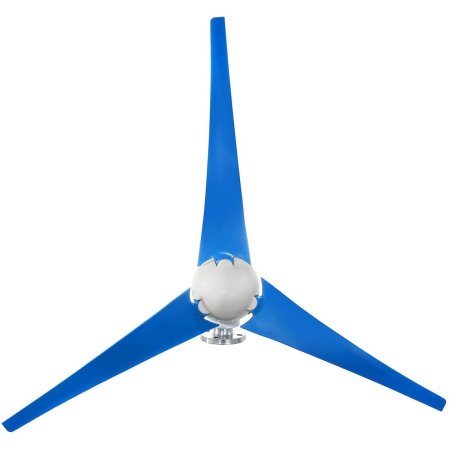
Pros
Cons
Product Specs
- Maximum power: 500 watts
- Rated wind speed: 29.08 miles per hour
- Number of Blades: 3
The Dyna-Living Wind Turbine Generator Kit is a surprisingly affordable home wind turbine that puts out a maximum of 500 watts of power and nearly 30 mph of rated wind speed. The entire unit is designed to be resistant to hot and cold temperatures, and to stay secure while running.
With this turbine’s start-up wind speed of just 4.47 miles per hour, users won’t need high winds to start generating power. The kit comes with a charge controller and a bag of mounting accessories. Its smaller size makes it a good pick for boats, RVs, and campsites, or it can be installed at home without being too obstructive.
Get the Dyna-Living wind turbine generator on Amazon.
Best for off-Grid Living
Primus Wind Power Air 40 Wind Turbine Generator
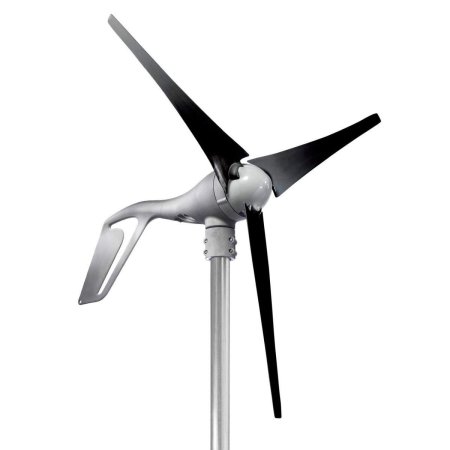
Pros
Cons
Product Specs
- Maximum power: 400 watts
- Rated wind speed: 13.4 miles per hour
- Number of blades: 3
This wind turbine from Primus can generate 40 kWh of energy each month at wind speeds of 13.4 miles per hour. Designed for land applications (there is also a model for marine applications for better corrosion sustainability), it comes with an integrated charger, meaning it’s easy to plug and play.
With a maximum wind speed of 110 miles per hour, this turbine is recommended for small charging operations, such as off-grid living and lighting. It also comes with integrated overcharge protection for the battery. The body is made of aluminum and the blades are made from a composite material. The turbine comes with a limited lifetime warranty and technical support.
Get the Primus wind turbine on Amazon.
Upgrade Pick
Nature Power 70701 Wind Turbine
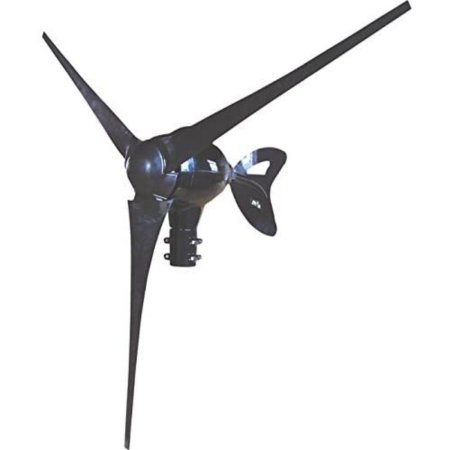
Pros
Cons
Product Specs
- Maximum power: 2,000 watts
- Rated wind speed: 45 miles per hour
- Number of blades: 3
For virtually any environment, this home wind turbine from Nature Power features an industrial-strength die-cast aluminum body and carbon fiber composite blades for exceptional durability even in marine or corrosive conditions. It also comes with a smart controller, which has a maximum power point tracking (MPPT) feature for efficient charging.
The turbine also automatically shuts down should wind speeds become too high, helping prevent damage. It also has a start-up wind speed of 7 miles per hour, so users won’t need very windy days to start generating power. The unit has also been constructed to operate quietly.
Get the Nature Power wind turbine on Amazon.
Best Wind and Solar Kit
ECO-WORTHY 800W Solar Wind Power Kit
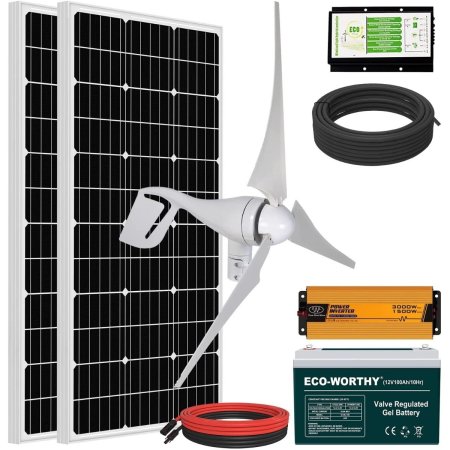
Pros
Cons
Product Specs
- Maximum power: 400 watts
- Rated wind speed: 23.5 miles per hour
- Number of blades: 3
This wind turbine kit from ECO-WORTHY comes with a solar panel in addition to the turbine and a battery for storing power. The battery automatically shuts down when it is fully charged, which prevents damage and short circuiting. It has a starting wind speed of 5.6 miles per hour.
The kit comes with a rechargeable battery, extension cables, a wind-solar hybrid controller, a solar panel, and an inverter. It is waterproof and can be used in different environments, so users don’t have to choose between land and water.
Get the ECO-WORTHY wind turbine on Amazon.
Best for Travel
Pacific Sky Power Travel Wind Turbine Generator
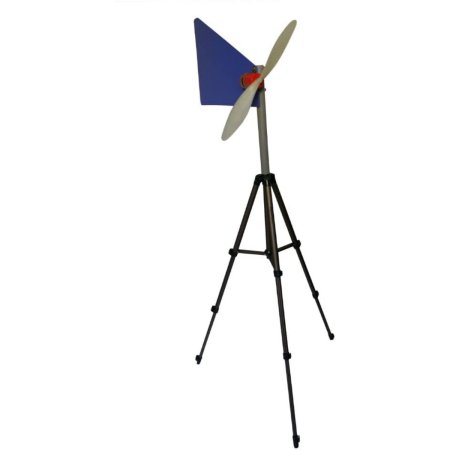
Pros
Cons
Product Specs
- Maximum power: 15 watts
- Rated wind speed: 15 to 25 miles per hour
- Number of blades: 3
For those looking for an easy-to-transport wind turbine they can take camping or on other travel excursions, this portable wind turbine from Pacific Sky Power puts out 15 watts of power and can keep cell phones and other electronics charged.
It also comes with a 50-inch mounting pole, unlike many other options, so users won’t need to buy a separate pole just to mount the turbine. It only needs 8-mph winds to charge a 6-volt battery and 12-mph winds to charge a 12-volt battery. Weighing just 3 pounds, this turbine is easy to transport just about anywhere.
Get the Pacific Sky Power wind turbine on Amazon.
Our Verdict
With all the wind turbines to consider, it’s essential to know what you’d like to power and what features are important to you (such as anti-corrosion blades) when choosing the best wind turbine. For most situations, we recommend the Pikasola wind turbine generator for its anti-corrosion and waterproof features. For those on a tighter budget, the budget-friendly Dyna-Living wind turbine generator kit offers low start-up wind speed and resistance to temperatures.
How We Chose the Best Home Wind Turbines
We chose the best wind turbines based on extensive product research as well as evaluating each model’s features, including waterproof ratings, assembly, price, and additional options such as MPPT controllers and kits that include mounting equipment or solar panels.
The Advantages of Owning a Home Wind Turbine
One of the biggest advantages of owning a home wind turbine is the ability to produce power without increasing carbon emissions or adding to a home’s energy bills. Since it generates electricity without cost, a wind turbine can pay for itself over time.
Having a more sustainable, renewable energy option has become a priority for many who want to increase their self-reliance and reduce their energy bills. However, a smaller wind turbine can also be the ideal travel companion when camping, traveling in an RV, or living off-grid.
- Reduce carbon emissions to be friendlier to the environment.
- Have a backup power source should the primary one fail.
- Reduce reliance on conventional energy sources.
FAQs
Below we have compiled a list of answers to some of the most common questions about wind turbines.
Q. How does wind create energy?
The blades of wind turbines collect kinetic energy from the wind, which spin around a rotor. The rotor is connected to a shaft, which in turn spins the generator to create electricity.
Q. How do I know if a wind turbine will work where I live?
There must be enough wind where you live in order for the turbine to work. Check daily wind speeds and compare them to the start-up and rated wind speeds of the turbines you’re considering.
Q. How big a wind turbine do I need to power a house?
Since the average home uses more than 10,000 kilowatt hours of electricity every year, you would need a wind turbine that puts out a minimum of 5 to 15 kilowatts (5,000 to 15,000 watts) to meet this demand.
Q. How much does it cost to install a wind turbine at home?
In addition to the cost of the turbine itself, you will also need to buy mounting equipment if your turbine doesn’t already come with it. Plus, depending on the turbine’s size, you may need to pay someone to install the pole and mount the turbine. Costs can range from several hundred dollars to thousands of dollars, depending on the size of the turbine.
Q. What happens if there’s no wind?
If there’s no wind—or there is less wind than the required start-up wind speed—the turbine will not generate power.
Q. Can a wind turbine withstand inclement weather?
Yes, but always check the maximum wind speed for the turbine. Any winds close to or higher than this amount can cause damage to the turbine.
Q. How much money will a wind turbine save me per month?
That depends on the energy output of the turbine. It could save a user anywhere from a few dollars to hundreds of dollars to much more, depending on how much power it generates (which, of course, is dependent on wind speed).
Q. What are the drawbacks of residential wind turbines?
Besides the fact that some people find turbines to be aesthetically unappealing, they can also be expensive to install. It’s important to check that the turbine you’re considering will work with the average wind speeds in your area to ensure you can generate enough power with the turbine.

